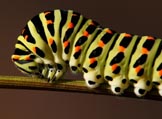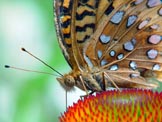
Life Cycle of a Butterfly Project(s)
In Search of Caterpillars
 For this project, you will need to find a caterpillar.
For this project, you will need to find a caterpillar.
It may not be as hard as you think.
That’s because butterflies lay their eggs on the plants that their caterpillars like to eat, which are called host plants.
Some common host plants for butterfly and moth caterpillars are alfalfa, aster, broccoli, cabbage, clover, dill, milkweed, parsley, snapdragon, and sunflower.
Trees that are hosts to caterpillars include birch, chokecherry and cherry, cottonwood, elm, oak, and willow.
(Here is a list of some common butterflies and their host plants.)
Ask an adult to help you figure out which of those plants you have in your yard or someplace near your home where you could go to look for caterpillars.
What You Need:
- clear plastic container (this jar will work well, or you could use something smaller)
- piece of cheesecloth
- rubber band that fits around the opening of the container
- scissors
- magnifying glass
What You Do:
1. Get an adult’s permission to go outside and search for caterpillars.
2. To search a plant, gently turn the leaves over one at a time by holding the stem and turning it slightly so you can see the back of the leaf. Look for holes in the leaves. If it looks like something has been eating it, there are probably caterpillars nearby! Keep looking through the plants, and on the ground around the plants.
3. If you find a caterpillar, carefully cut the leaf or part of the plant that it is on and put it into your container; don’t pick the caterpillar up or take try to take it off the plant because it can hold on tightly and you may hurt it. Cover the container with cheesecloth and put a rubber band around it so your caterpillar can breathe but can’t escape.
4. If you find any very tiny caterpillars, they may have hatched recently! Use your magnifying glass to look more closely at the backs of leaves to see if there are any butterfly eggs that have not hatched into caterpillars yet. If you find any, don’t touch them, just look.
Now What?
Put a few small twigs and blades of grass in the container to give your caterpillar more interesting places to explore. The caterpillar will not need any water, but it will be very hungry, so make sure you remember what plant it was eating when you found it so that you can get fresh leaves from the same kind of plant. Feed your caterpillar once a day, or more often if it eats all the fresh leaves sooner. Take the old leaves out before putting new ones in. Let the caterpillar go after a couple days.
Note: Instead of finding your own caterpillars, you can order some. You will not need to feed these caterpillars anything because the containers that they come in have all the food they will need, but you can watch them eat and turn into butterflies!
Make a Butterfly Feeder
What You Need:
- a plastic lid (from an empty sour cream container or other container)
- a hole punch
- string or yarn
- scissors
- construction paper or artificial flowers
- several slices of fruit that are too ripe to eat
- orange juice
What You Do:
1. Get an adult to help you use the hole punch to punch four holes in the lid just inside the rim. Punch one hole at the top of the lid, one at the bottom and another one halfway in-between those holes on each edge.
2. Cut four pieces of string that are each about 12″ long. Tie one end of each string through each of the holes and around the rim of the lid. Pull the loose ends of all four strings together at the top (the rim of the lid should be facing up) and tie them together in a knot.
3. Cut colorful flowers out of construction paper and tape them to the strings to help you feeder attract butterflies. (You could use artificial flowers instead.)
4. Arrange a few slices of the ripe fruit on the lid. Fruits that are very juicy will attract butterflies the best. Some good ones to use are oranges, watermelon, grapes, or pears. Bananas also work well if you freeze them and then thaw and slice them. If some of the fruit does not seem very juicy, pour a few drops of orange juice on it to keep it from drying out as quickly.
5. Take your feeder outside and hang it from a tree branch. Since the sweet fruit will probably attract other insects like bees and flies, you should not hang it near your house or sidewalk.
6. Watch to see what kind of butterflies come to eat at your feeder. Do you think different kinds of butterflies like different kinds of fruit? How many butterflies eat from your feeder at once? How does a butterfly eat?
What Happened:
Butterflies love to drink nectar. The sweet juice from fruit is like nectar.
Butterflies don’t have noses, but they can sense smells through their antennae and their feet!
When a butterfly lands on liquid, it knows it is something it could eat and its proboscis uncurls to drink up the liquid! A proboscis works sort of like a drinking straw and the liquids that it sucks up through its proboscis go directly into the butterfly’s body.
Colors also help butterflies find food. Their favorite colors are purple, red, orange, yellow, and pink, because those are the colors of most flowers that have sweet nectar that butterflies can easily drink.
Observe Symmetry
What is symmetry?
When something is exactly the same on both sides, it is symmetrical.
True symmetry means that one side is a mirror image of the other side, so if you could draw a line down the middle of an object and fold it in half along the line and the two halves matched up to each other perfectly, the object would be symmetrical.
Symmetry can be seen in lots of things around you.
Here are some examples: snowflakes, butterfly wings, insects and spiders, seashells, flowers, letters, shapes, buildings, your body, and many more. Some things may seem symmetrical, but really aren’t exactly the same on both sides.
One example is your face. Even though it looks mostly the same on each side (you have two eyes and ears and your forehead, mouth, nose and chin are all shapes that can be split in half), there are small differences that are hard to notice unless you look very closely.
Can you find any examples of symmetry? Look around your house or take a quick walk outside to find some things that are symmetrical.
How many of your objects are things found in nature, or not created by humans? Print out this worksheet and decide which of the pictures are of something symmetrical and which ones are not.
Butterfly Science Lesson
The Life Cycle of a Butterfly
A butterfly is an insect. It has three main body parts – a head, thorax, and abdomen.
It also has six legs, two compound eyes, and two pairs of wings.
Before a butterfly becomes a butterfly, it is a caterpillar, which is also an insect, even though it looks very different from a butterfly and does not have any wings.
The incredible transformation that a caterpillar goes through to become a butterfly is called metamorphosis.
(Did you read about a ladybug’s metamorphosis in another article?)
There are four stages that a butterfly goes through in its life. The stages are called a life cycle and are explained below.
Egg
When a female butterfly becomes an adult, she will lay an egg – or maybe a cluster of several eggs – on a leaf of her favorite plant.
A butterfly egg is very tiny and a little bit sticky so it will stick to the leaf until it hatches.
About 4-10 days after the egg is laid, a tiny caterpillar will hatch from it!
All the little caterpillar will want to do is eat. It will start eating the leaves of the plant it hatched on almost as soon as it is out of its egg.
Lots of caterpillars also eat the shell of the egg they have hatched out of.
Larva
The tiny caterpillar is called a larva and will eat a lot to prepare for the amazing transformation it will go through during the next stage of its life.
As it eats, it will get too big for its skin and will shed its top layer of skin to reveal a larger brand new layer of skin underneath!
This will happen about four or five times during the larva stage. Because a caterpillar is an insect, it has three pairs of true legs on the front part of its body (the thorax), plus lots of other legs called prolegs that it uses to climb and cling to things.
The caterpillar will keep eating and growing for several weeks until it is time to move on to the next stage.
Pupa
After awhile the caterpillar will stop eating. It is now much bigger than it was when it first hatched from its egg and it is ready to develop into the next stage – a pupa.
The caterpillar begins searching for the perfect place to turn into a pupa or chrysalis.
It looks for a place that feels safe and then attaches itself securely, usually upside down, to the spot (like a plant stem or side of a leaf or solid object) using strands of silk. Then it sheds its skin one last time.
This time, the new skin underneath is not soft and flexible; it is hard and smooth and makes a case around the caterpillar’s whole body.
The chrysalis hangs from the spot for several days, weeks, or even months, depending on what type of butterfly pupa it is. While the butterfly is in the pupa stage, some incredible changes are happening inside the chrysalis and it will look much different when it finally comes out!
Adult
Soon the pupa will be finished developing and a butterfly will break out of the chrysalis.
It has changed from a long caterpillar that crawls along and uses jaws to eat leaves into a dainty butterfly that can fly using its colorful wings and eats by sucking nectar from flowers.
When a butterfly first emerges from its chrysalis, its wings are folded up and slightly damp.
It will stay there for awhile and pump blood through the veins in its wings and allow the air to dry them. Then it will fly away and look for its first sip of nectar and begin its search for a mate. A female butterfly will lay eggs and the life cycle will start all over again.
Butterfly wings are usually very colorful with pretty patterns on the top side of their wings while the underside of their wings are usually darker, more drab colors.
Butterflies usually rest with their wings closed and the dark colors help them blend in with their surroundings, making it harder for birds and other predators to see them.
The colors on the surface of a butterfly’s wings are made up of lots of little tiny scales.
If you were to touch a butterfly’s wings, you would notice some colored powder-like substance on your fingers.
Those are the tiny scales! A butterfly eats through its proboscis (say: PRO-BO-SIS), which is very similar to a straw that you would use to drink a beverage, except that it is connected to the butterfly in place of a mouth.
Female butterflies are usually larger than males and they usually live a little longer than males.
Links:
- Pictures of a Black Swallowtail butterfly emerging from its chrysalis.
- Fascinating life cycle of a butterfly from larva to adult with a Butterfly Garden.
Butterfly Senses
 Butterflies do not see, hear, smell, taste, and feel the way we do. Even though they can do all of these things, their senses are very different from human senses and might not be quite what you would expect!
Butterflies do not see, hear, smell, taste, and feel the way we do. Even though they can do all of these things, their senses are very different from human senses and might not be quite what you would expect!
Seeing – Butterflies have large compound eyes, just like most other insects do. Compound eyes have many lenses instead of just one like our eyes and they allow insects to see in many different directions at once, which helps them know when there are predators or other dangers around. Their compound eyes are part of the reason that butterflies often fly away so quickly when you start to get close to them.
Hearing – Butterflies do not have ears, so they can’t hear sounds like we can. However, their wings are very sensitive and they can feel the vibrations (very fast back and forth movements) that different sounds make. Since they feel sound instead of hearing it, they can really only “hear” loud sounds or big changes in the amount of sound around them.
Smelling – Butterflies can smell quite well, but they don’t have noses! They can smell through their feet and their antennae.
Tasting – They can also taste through their feet! They have special parts on their feet that help them sense what something tastes like to help them decide if it is something that is good to eat or not. They can also taste through their antennae.
Feeling – Since they have six feet, they have lots of things to feel with. Butterflies, like all insects, have two antennae, which help them feel too. They also have lots of tiny hairs on their bodies that help them feel movements.
Butterflies vs. Moths
Butterflies and moths look and act pretty similar, but here are some important differences that will help you tell them apart:
- Butterflies have thin antennae with “clubs” on the ends and moths have fuzzy or feathery antennae, usually without “clubs.”
- Moths usually have shorter, fatter, and furrier bodies than butterflies.
- Moths are nocturnal, which means they are most active at night and sleep during the day. Butterflies are most active during the day.
- Because moths are nocturnal, their wings usually have darker colors than most butterfly wings.
- Butterflies rest with their wings folded and pointing up above their bodies and moths land with them open or else down covering their bodies.
- Butterflies make chrysalides during the pupa stage and moths make cocoons.
Science Words
(Note: plural means more than one)
Proboscis – the straw-like tube that butterflies use to drink nectar and other liquids.
Symmetrical – having two sides that look exactly the same.
Metamorphosis – a transformation that many insects and animals go through before getting to the adult stage. The changes that take place are very dramatic.
Larva (plural = larvae) – a middle stage of an insect’s life cycle. In a butterfly, the larva is a caterpillar.
Prolegs– legs on the end section (the abdomen) of larvae (caterpillars).
Pupa (plural = pupae) – a later stage of an insect’s life cycle. The complex changes that happen before the insect becomes an adult happen in this stage. In a butterfly, the pupa is a chrysalis.
Chrysalis (plural = chrysalides) – the protective outer covering of a butterfly pupa.
Nocturnal – active at night and asleep during the day.
Printable Worksheet & PDF
Use this worksheet to help kids review symmetry.
Discuss how butterflies and moths exhibit symmetry or use with the Observe Symmetry activity.






